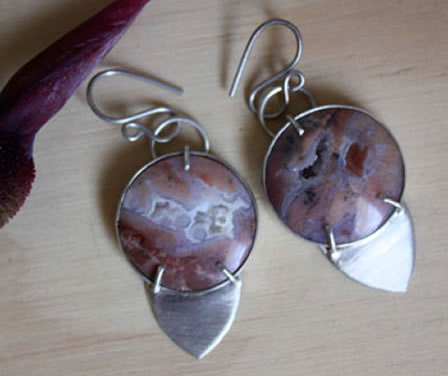- Jewelry
- Inspiration
- Good Deals
- Paintings
- About
- Contact
JEWELRY
- Anklet
- Bracelets
- Brooches
- Cufflinks
- Earrings
- Pendants & Necklaces
- Rings
- Draw your jewelry
- GOOD DEALS
- How to clean your jewel
- Metal we used
INSPIRATION
Youngite: history, healing properties and lithotherapy

Youngite properties

Youngite is a rare and precious stone, composed of a unique blend of silicified jasper and microcrystalline quartz in druse form. This combination gives it remarkable durability and a natural luster, making it highly sought after by collectors and mineral enthusiasts.
It is primarily mined in the state of Wyoming, USA, a region known for its silica-rich rock formations and rare minerals. Its geological origin makes it particularly fascinating, as it forms through slow processes of precipitation and crystallization of silicates within rock cavities.
Youngite is distinguished by its shades ranging from pink to beige, sometimes marbled with darker patterns that reflect its heterogeneous composition. Some specimens also exhibit slightly greenish hues due to the presence of mineral impurities.
It has a microporous structure, meaning it can contain slight inclusions of water or gas trapped during its formation. This characteristic contributes to its unique sheen when viewed from different angles.
One of the most intriguing aspects of youngite is its slight fluorescence under ultraviolet light, which is attributed to its low natural radioactivity. This fluorescence is due to trace amounts of uranium, an element sometimes found in silicate minerals from Wyoming. However, these radiation levels remain entirely harmless to humans, making the stone safe to handle and wear as jewelry or decorative objects.
Youngite results from a silicification process, where silicate minerals gradually infiltrated a jasper matrix, solidifying it and giving it properties similar to quartz.
Its hardness is estimated between 6.5 and 7 on the Mohs scale, making it relatively resistant to scratches and well-suited for cabochon cutting or collectible pieces.
Composition of Youngite:- Microcrystalline quartz, providing its fine and durable structure
- Silicified jasper, contributing to its varied hues and distinctive patterns
- Trace elements such as iron and manganese, responsible for its color variations
- Uranium traces, explaining its fluorescence under UV light
Thanks to this unique composition, youngite is not only a rare mineral but also a prized specimen among collectors and mineralogy enthusiasts.
Mines: the USA.
History, legends and beliefs about youngite
Although little known outside specialized mineralogy circles, youngite captivated the attention of Native American populations in Wyoming long before its official discovery. This stone, combining jasper and quartz, was regarded as a bridge between the material and spiritual worlds. Shamans used it in rituals to connect with spirits and ancestors.
Local tribes, including the Lakota and Shoshone, are believed to have used youngite in ceremonies to enhance mental clarity and spiritual guidance. Its deep connection to the earth and natural forces made it a key element in healing practices, where it was placed on altars or worn as a talisman by elders and healers.
Some shamans believed that its fluorescence under ultraviolet light was evidence of its link to the unseen world, further reinforcing its reputation as a mystical stone. It was particularly used to: facilitate shamanic journeys and spiritual trances, protect against negative energies and malevolent spirits, receive visions and messages from ancestors.
Healing properties and benefits
- In addition to its unique characteristics, youngite inherits the virtues of both jasper and quartz, which compose it. The microcrystalline quartz enhances its energetic properties and amplifies its effects, while the jasper provides stability and protection.
- Youngite is reputed to reduce stress and promote a state of serenity. It helps dissipate anxiety, calm excessive thoughts, and create an atmosphere conducive to relaxation and meditation.
- Through its interaction with the body’s energies, it is believed to benefit the nervous system, helping to soothe nervous tension, improve concentration, and support more restful sleep.
- This stone is also used to stimulate the mind, enhance memory, and clarify thoughts, making it a valuable ally for those in need of greater focus in intellectual pursuits.
- Youngite is thought to boost brain function and improve nerve signal transmission.
- It may strengthen the respiratory system and help soothe minor respiratory ailments.
- This stone is believed to support better digestion and aid in the elimination of toxins.
- Youngite is thought to contribute to the body’s natural defenses.
- It may improve blood circulation and reduce the risks of energy stagnation.
- By supporting metabolism and facilitating the elimination of accumulated acids in the body, this stone is believed to alleviate pain associated with gout and joint inflammation.
- Due to its connection with the earth and mineral elements, youngite is also regarded as a grounding and protective stone. It is believed to strengthen the aura, ward off negative influences, and stabilize internal energies.
- Finally, because of its natural fluorescence and its link to shamanic beliefs, youngite is sometimes used to enhance clairvoyance, open intuition, and support deep meditation.
 Please note that all healing properties presented for gemstones are gathered from various sources. This information is provided as a service and is not intended to treat medical conditions. It is recommended to consult a healthcare professional for serious medical issues and not to rely solely on gemstones as a treatment.
Please note that all healing properties presented for gemstones are gathered from various sources. This information is provided as a service and is not intended to treat medical conditions. It is recommended to consult a healthcare professional for serious medical issues and not to rely solely on gemstones as a treatment.
Youngite jewelry samples
To learn more about litotherapy, we recommend you the following books:




